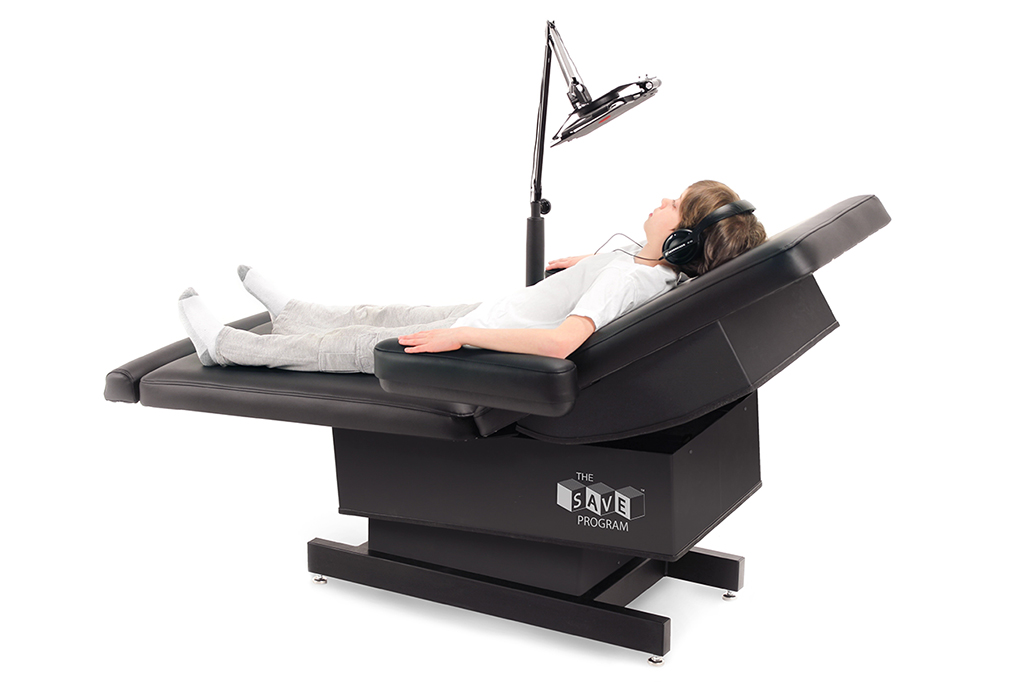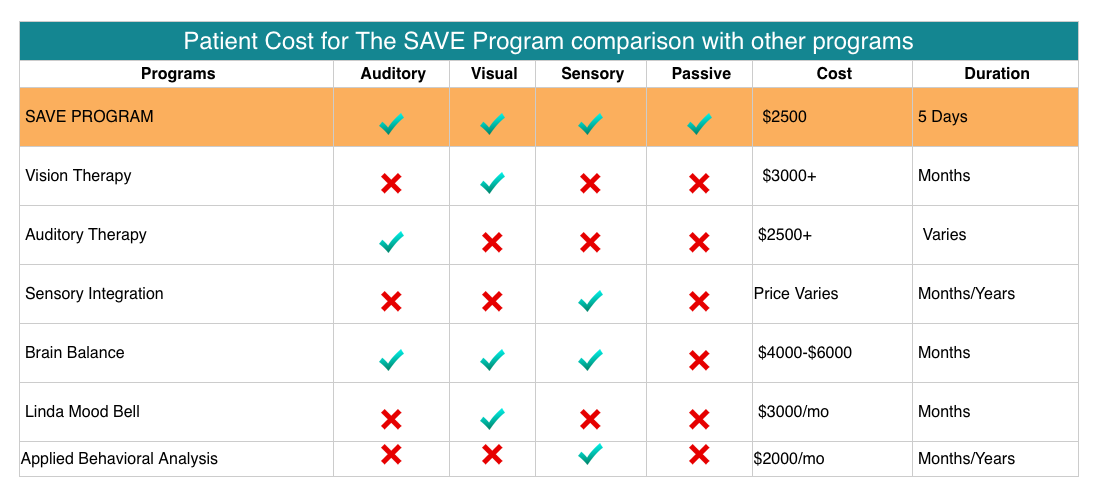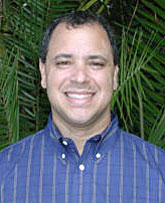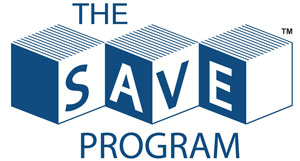5 DAYS
NO DRUGS
REAL RESULTS

The SAVE Program is an accelerated sensory integration program that takes only 5 days to complete. SAVE stands for Sensory-motor Auditory Visual Education. It stimulates five senses simultaneously, which creates these rapid results. This 5-pronged approach helps develop, retrain and expand the ability to take in, understand and use information more effectively.
Why the SAVE Program works in only 5 days
It combines five senses at one time to which is proven in research to work faster and be more effective.
The program is concentrated, ten hours in five days, to continuously override old and produce new sensory pathways.
It is automated for a consistent training to maximize the benefits.
The system takes sensory integration to a new level of training using digital technology. It is based on decades of published research as well as years of clinical results on The SAVE Program itself.
This is important when you realize that some children and adults cannot follow directions to do the activities that other programs require. The client just relaxes while the program works for them.
What is the SAVE Program?
SAVE stands for Sensory-motor, Auditory, Visual Education. It is an accelerated sensory integration program that stimulates five different senses simultaneously. This creates a comprehensive and more effective approach to retraining the sensory systems in a shorter period of time and at less cost.
What are the benefits of The SAVE Program over other forms of sensory integration?
Primarily, The SAVE Program combines five major senses at one time, touch (tactile), Sound (auditory), Sight (visual), Vestibular (movement and balance sense) and Proprioception (joint/muscle sense) while many other programs focus on one sense at a time such as auditory therapy or visual therapy. Secondarily, SAVE works faster than any other program.
Why is it important to target all five senses at the same time?
People use all their senses at one time to perceive and interact in their environment, not just one sense at a time. For example, it would not be very effective to try to learn to ride a bicycle blindfolded. A person uses their sense of sight, sound, touch and balance to learn and use this skill. The more of our senses we use and the more they function together is what enhances the learning process. That is why training multi-senses at the same time can not only help to develop each sense but also train them to work together more optimally. A better integration of the senses can help lay down a fundamental foundation from which awareness, perception, reasoning, judgment and knowledge can develop and grow.
Do participants ever need to repeat The SAVE Program?
Rarely is it ever needed. The five day, 10-hour training program is all it takes to optimize the sensory integration experience. Occasionally, if the participant has an accident such as a fall that causes head injury or if they do not follow the directions for the 30 days after, some benefits can be lost and a repeat of the program may be helpful.
How long do the effects of The SAVE Program last?
The effects of the training continue to expand. Once the senses are stimulated to work more effectively they continue to do so and the ability to take in and use information more effectively continues to improve. The SAVE program is designed to help people develop or regain their ability to use their senses more optimally. Once in place, they build from that foundation and expand on these abilities. If the program helps a child read better, the child can learn more from printed information. If it helps them listen better, they will take in oral information to expand their knowledge and social skills. A better integration of the senses can help lay down a foundation from which awareness, perception, reasoning, judgment and knowledge can develop and grow.
What is Sensory Integration?
Jean Ayres defined sensory integration as “the neurological process that organizes sensations from one’s own body and from the environment and makes it possible to use the body effectively within the environment”. This theory explains why individuals respond in a certain way to sensory input.
Is Sensory Integration similar to biofeedback?
No. Biofeedback is a technique that is taught to control body functions, such as heart rate, blood pressure, muscle tension etc. Sensory integration is a program that designed to help optimize the senses, a fundamental way in which we take in and use information.
How does it feel to go through the training?
It is very gentle and relaxing. Participants usually enjoy the experience and many feel comforted by it. Children on the autism spectrum often leery of new sensory experiences, after one or two training session happily walk (some run) into the room and climb on the chair without being asked.
What is included with The SAVE Program?
The SAVE Program includes the following items:
• One Motion Chair
• One Computer with Software
• One Audiometry Testing Device
• Visual Field Testing Device
• One Set of Bluetooth Headphones
• One Set of Ear Covers
• Instruction Manuals and Videos
• Manuals on how to do the testing
• Client Information and Progress Forms
• Marketing and information materials
• Access to The SAVE Program Dropbox with support materials
• Other educational and training material
• Access to SAVE Program staff for support and questions
What if a person cannot do the sensory integration activities or follow the directions needed to benefit from the training?
The SAVE Program is automated and passive, requiring no effort on the part of the client. The participant does not need to do anything to benefit from the program. The sensory stimulation it provided to the participant when s/he reclines of the training chair, watches a screen that provides the visual therapy, listens to the special music for the auditory therapy and the chair gently moves in just the right pattern and speed to integrate the sensory-motor and tactile therapy. Because it is automated, it provides a consistent training to everyone which does not hinge on how well the staff teaches the activities or how well the participant performs them.

The number of attention deficit disorder (ADHD) diagnoses continue to climb steadily in the United States, up from 7.8 percent in 2003 to 11 percent in 2011. Despite the growing number of individuals with ADHD, it is still a widely misunderstood condition burdened by myths, such as, “you can’t have ADHD if you’re not hyper,” and, “everyone grows out of ADHD eventually.” The fact is, it’s a complex disorder with varying symptoms that morph and persist through adulthood for many people. Here are the facts about ADHD.
What is ADHD?
Attention Deficit Hyperactivity Disorder, or ADHD (formerly known as ADD), is defined in the DSM-V as “a persistent pattern of inattention and/or hyperactivity-impulsivity that interferes with functioning or development, has symptoms presenting in two or more settings (e.g. at home, school, or work; with friends or relatives; in other activities), and negatively impacts social, academic or occupational functioning.”
The ADHD symptoms listed below (taken from the DSM-V) must start by age 12 but can continue throughout adulthood. To merit a diagnosis, a patient must demonstrate at least six of the following symptoms for six months or longer in at least two settings — for example, home and work.



Symptoms of Inattention
- Often fails to give close attention to details or makes careless mistakes in schoolwork, work, or other activities
- Often has difficulty sustaining attention in tasks or play activities
- Often does not seem to listen when spoken to directly
- Often does not follow through on instructions and fails to finish schoolwork, chores, or duties in the workplace (not due to oppositional behavior or failure to understand instructions)
- Often has difficulty organizing tasks and activities
- Often avoids, dislikes, or is reluctant to engage in tasks that require sustained mental effort (such as schoolwork or homework)
- Often loses things necessary for tasks or activities (e.g., toys, school assignments, pencils, books, or tools)
- Is often easily distracted by extraneous stimuli
- Is often forgetful in daily activities – even those the person performs regularly (e.g., a routine appointment)
Symptoms of Hyperactivity/Impulsivity
- Often fidgets with hands or feet, or squirms in seat
- Often leaves seat in classroom or in other situations in which remaining seated is expected
- Often runs about or climbs excessively in situations in which it is inappropriate (in adolescents or adults, may be limited to subjective feelings of restlessness)
- Often has difficulty playing or engaging in leisure activities quietly
- Is often “on the go” or often acts as if “driven by a motor”
- Often talks excessively
- Often blurts out answers before questions have been completed
- Often has difficulty awaiting turn
- Often interrupts or intrudes on others (e.g., butts into conversations or games)

I was skeptical non-believer.
…Until I saw for myself the benefits of The SAVE Program.
As the father of twin boys who have struggled with focusing in school and in life, I know what it’s like to search for a treatment that is truly effective, and free of harmful side-effects. When I discovered The SAVE Program, I knew I needed to share this resource with fellow parents and patients.
Dr. Penge received a Bachelor of Science degree from Vanderbilt University. After this, he went on to graduate study in psychology at the University of Florida. It was while at Florida that he was introduced to chiropractic after suffering neck, arm and hand pain. After experiencing remarkable relief from these symptoms, he decided to make chiropractic his life’s work, and went on to Life Chiropractic College, where he received his Doctor of Chiropractic degree.
Penge Chiropractic
Penge Chiropractic
2727 S. Tamiami Trail Ste. 3
Sarasota, FL 34239
Penge Chiropractic
941-365-4343
2727 S. Tamiami Trail Ste. 3
Sarasota, FL 3423
Check our practice website to see our normal chiropractic practice hours. The SAVE Program requires a custom schedule for each patient. Please call our office to discuss availability of start dates.
